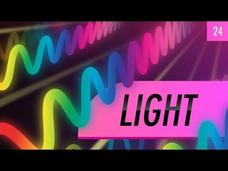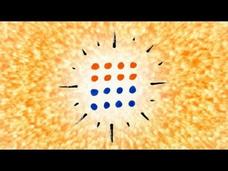Crash Course
Stars
Star light, start bright! What do the brightness and color of stars tell us about the stars we see at night? Learners explore the life of stars with an information-packed video. Topics include the relationship between mass and...
Crash Course
Light
All this talk about seeing the light... but, what is it, and how do we see it? Science students learn the basics of the nature of light in a narrated video that discusses concepts such as how light behaves, the electromagnetic...
MinutePhysics
Is the Universe Entirely Mathematical? Feat. Max Tegmark
Does one formula or set of theorums explain everything in existance? A video ponders whether or not everything in the universe is entirely mathematical.
MinutePhysics
A Polarizing Discovery About the Big Bang!
The Big Bang just got bigger! Learners explore the early universe in a short, animated video. The narrator guides viewers through the revelation that photons polarized by masses of plasma travel through space to bring us a...
MinutePhysics
YouTube Video vs. The Universe
Our world seems to be a pretty big place ... until you compare it with the rest of the universe. Where does Earth fit in? Space science scholars watch as the narrator uses a tiny pixel to illustrate how much room we take up in space.
MinutePhysics
How Big is the Universe?
Can you measure the size of something that's getting bigger all the time? It depends upon your perspective! Space scholars discover fundamental facts about our ever-growing universe. The narrator explains the difference between the...
TED-Ed
How Small Are We in the Scale of the Universe?
There are so many galaxies in the universe that the vast majority of them are too distant for the human eye to perceive. An astronomy video discusses the Hubble Telescope's Deep Field image from 1995 and the eXtreme Deep Field image...
MinutePhysics
Why Is It Dark at Night?
Don't keep your physics class in the dark about night—introduce them to the concept with a short animated video! The narrator discusses how the Big Bang set our universe into an ever-expanding motion where the stars we observe now appear...
MinutePhysics
Tutorial: Simulating the Universe in After Effects
Create the universe on your laptop in just over five minutes! The video tutorial guides scholars step by step through the process of simulating the Millennium Run using Adobe After Effects. Watch as the narrator illustrates how...
MinutePhysics
Picture of the Big Bang (a.k.a. Oldest Light in the Universe)
Everyone knows the Big Bang Theory ... but, then what happened? Go beyond the bang in an illustrated video that discusses the after effects of the event that set our universe in motion. Physics scholars discover how the creation of...
MinutePhysics
Tour of the Map of the Big Bang
Tour the universe from the comfort of your own desk! View the video to learn more about bigbangregistry.com, an interactive map of the great beyond. Pupils discover cosmic background radiation, the oldest light in the universe. The...
MinutePhysics
Theory of Everything (Intro)
One equation to rule ... everything? Introduce your class to The Standard Model, a simple(ish) equation that explains how things happen in the world around us—and far beyond Earth. Individuals view examples of the factors involved...
The School of Life
Burke on: The Sublime
Feeling small and insignificant doesn't always have to be a negative sensation. Explore the sublime with a video analysis of Edmund Burke's 1757 work A Philosophical Enquiry into the Origin of Our Ideas of the Sublime and Beautiful,...
MinutePhysics
2011 Nobel Prize: Dark Energy feat. Sean Carroll
In 2011, a Nobel Prize was awarded for explaining how dark energy is causing solar systems to move away from each other at increasing speeds. The video highlights the theories the discovery was based on and the connection to Einstein.
SciShow
5 Baffling Mysteries About the Universe
How close are scientists to understanding the universe? Big discoveries bring us closer to understanding, but they also open up more questions that we previously didn't know to ask. This video includes explanations of what we don't know...
SciShow
How Do We Measure the Distance of Stars?
While a cosmic distance ladder sounds like fun, it is actually the name given to the variety of methods astronomers use to determine the distance to objects in space. This video examines the method of determining the distance of a star...
SciShow
How Many Stars Are There?
Are there more stars in the universe than grains of sand in the sea? This video looks at the way scientists attempt to answer this question by using data from NASA and focusing on observable space.
SciShow
Blazars Are A Thing
Blazars are one way of viewing a quasar. For many years, people believed these were separate things because they appear much different, but more recent research has proved this wrong. A video explains what each is, why we thought they...
SciShow
Dark Energy
Dark energy makes up more than 70 percent of the energy in the universe, yet scientists can't really explain it. Video attempts to explain what dark energy is and why we can't answer that question. It offers multiple theories and...
Be Smart
What Color is the Universe?
What colors are the sun, our galaxy, and the universe? An engaging video provides an overview of each and why what we think we are seeing is often wrong. It provides explanations for how to understand colors that aren't in the...
Be Smart
The Cosmic Afterglow
A short video explains one piece of research that supports the Big Bang Theory. The discovery of the sound of radiation from the photons during the creation of our universe is a sound we all recognize as static, but we often...
Be Smart
How Big is the Solar System?
Provide a visual reference to just how far apart the planets in our solar system are. Starting from a grapefruit representing the sun, the speaker in an engaging video walks the relative distance between each planet.
Be Smart
The Far Future of the Universe
Ever wonder what will happen to our earthly home if we continue to evolve at the current rate? Learners view the video segment and witness predictions of what could occur in the future, even millions of years from now, as time progresses...
Crash Course Kids
Life on Other Planets
Is there life beyond Earth? Take a look through a virtual telescope in a video that provides possible scenarios in which life could exist on other planets.























